Warner Brothers Vitaphone/Warner Home Video (1930-32 / 2010), 2 discs, 192 mins, 1.33:1, Dolby Mono, Not Rated, $24.95 (available online only from the Warner Archive Collection)
The Movie:
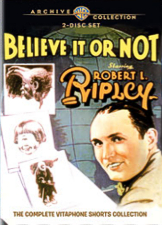 Though the announcement of the Warner Bros. Home Entertainment Archive Collection was met by equal excitement and derision by fans and those critical of the manufactured on demand aspects of the line, the move to bring the Studio’s impressive, if actually unwieldy, library of titles, has proven to be a big hit with collectors.
Though the announcement of the Warner Bros. Home Entertainment Archive Collection was met by equal excitement and derision by fans and those critical of the manufactured on demand aspects of the line, the move to bring the Studio’s impressive, if actually unwieldy, library of titles, has proven to be a big hit with collectors.
Titles from the Warner Bros. Pictures the Studio naturally own to the numerous buyouts of other output, most notably the immense number of Metro-Goldwyn-Mayer classics through the acquisition of Turner Entertainment as well as those from RKO, Lorimar and various other smaller distributors including many independents have been notorious to come by, and the Archive Collection allows WB to put out rarities and some of the more obscure titles in their catalog; titles that may have their fans but otherwise not the kinds of numbers clambering to own them and make a mainstream DVD release even a moderate hit.
Such has been the waves caused by the WB Archives that other studios have been quick to follow: at my last check, Universal and MGM both have exclusive manufactured on demand deals with Amazon on selected titles. The basic scheme is simple: current video masters for many requested films are dusted down and encoded using a propriety process to blank DVD discs, simultaneously providing fans with some of the hard to get titles they’ve been waiting patiently for and a way for the studios to get some of their more requested (but way down the restoration line) titles out on disc (and bring in a little revenue on masters that would otherwise stay lined up on shelves). Sure, these discs may be priced a little over the odds, but for those that can appreciate they are made to order discs (and without any burnt in TCM-like corner logos) but they’re the only way to own good quality prints that, while may not have been restored to pristine condition, are still better than broadcast television.
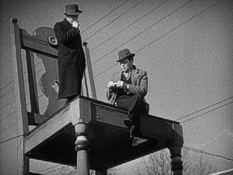 One of the best ways the line has been utilized is with large groupings of legendary, but rarely seen, theatrical short subjects, with WB Archive multi-disc sets pulling together a host of collections featuring high-profile names long-forgotten by the majority of all but the die-hard nostalgic collectors. As one of those kinds of people, I’m lapping it all up, and especially enjoy the mix of kitschy titles that I grew up on (Captain Sindbad, Captain Nemo And The Underwater City, Doc Savage), early cinema revues (the wonderful Hollywood Revue Of 1929) and full libraries of short films that I’ve only been able to tantalisingly glimpse as one-off bonus features on mainstream discs.
One of the best ways the line has been utilized is with large groupings of legendary, but rarely seen, theatrical short subjects, with WB Archive multi-disc sets pulling together a host of collections featuring high-profile names long-forgotten by the majority of all but the die-hard nostalgic collectors. As one of those kinds of people, I’m lapping it all up, and especially enjoy the mix of kitschy titles that I grew up on (Captain Sindbad, Captain Nemo And The Underwater City, Doc Savage), early cinema revues (the wonderful Hollywood Revue Of 1929) and full libraries of short films that I’ve only been able to tantalisingly glimpse as one-off bonus features on mainstream discs.
Finally, we’ve been able to enjoy the MGM Our Gang shorts in full, as well as the hilarious Dogville Comedies and sets dedicated to two comics whose films I was only ever to find late night or early morning as TV filler: Robert Benchley (he of Disney’s The Reluctant Dragon studio tour feature) and everyman Joe McDoakes (and here’s hoping that further sets for the oeuvres of Edgar Kennedy and Leon Errol are only just around the corner). What makes these sets most fun is the feeling of returning to when movie houses played a full night’s worth of programming, from the newsreels, animated cartoons and a short subject before the main feature, and any one of Warners’ vintage sets will put you right back in time to a 1930s or 40s cinema seat for a night of pure nostalgia.
 Believe It Or Not!, featuring the celebrated discoverer of strange things, Robert L Ripley, is a collection of short subjects that fall somewhere as a cross between the newsreels of the day and those odd, curious travelogue tours of far off lands and the people that reside there. Ripley had started as a newspaper cartoonist, detailing a 1922 trip around the globe in his strips, taking in some of the unknown customs that other countries practised, as well as drawing attention to the many weird and wonderful people and places he came across. Ripley was a devout attention to detail; though many of his discoveries may seem extreme, they were researched thoroughly, a fact that was not lost on newspaper magnate William Randolph Hearst, who syndicated Believe It Or Not! and produced a book edition based on Ripley’s writings in 1929.
Believe It Or Not!, featuring the celebrated discoverer of strange things, Robert L Ripley, is a collection of short subjects that fall somewhere as a cross between the newsreels of the day and those odd, curious travelogue tours of far off lands and the people that reside there. Ripley had started as a newspaper cartoonist, detailing a 1922 trip around the globe in his strips, taking in some of the unknown customs that other countries practised, as well as drawing attention to the many weird and wonderful people and places he came across. Ripley was a devout attention to detail; though many of his discoveries may seem extreme, they were researched thoroughly, a fact that was not lost on newspaper magnate William Randolph Hearst, who syndicated Believe It Or Not! and produced a book edition based on Ripley’s writings in 1929.
The wider exposure did him nothing but good: within a year, Ripley was a voice on radio, reporting from various remote locales around the world and serving up odd trivia: after announcing, believe it or not, that America did not have its own national anthem, President Hoover adopted The Star Spangled Banner in 1931. The same year saw Ripley bring his radio persona to the screen: the television Believe It Or Not! wouldn’t come until 1948, but his popularity was enough for the Vitaphone Corporation to sign him up for a series twelve theatrical shorts (1930-31), the popularity of which were enough to warrant a second twelve the following year (1931-32).
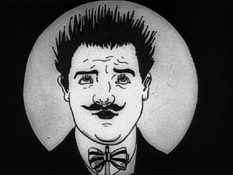 A mix of obscure facts, figures and funny-peculiar sights and sounds from around the globe, each reel is hosted by the personable Ripley himself, though the globe-trotting exploits are sadly kept to a minimum. For instance, the first episode finds him at his drawing desk, coming up with images to illustrate his trivia, the editing allowing him to create quite detailed pictures seemingly within seconds. There are increasing amounts of location inserts as the series progresses, but much of it is studio bound. Each reel (episodes vary only slightly in length from around six to nine minutes on average) has Ripley in a different fixed set up: in the second film he’s in a courtroom, having to prove his sometimes wild tales; in the third on a luxury liner, recounting his exploits to the journalists who have come to greet him.
A mix of obscure facts, figures and funny-peculiar sights and sounds from around the globe, each reel is hosted by the personable Ripley himself, though the globe-trotting exploits are sadly kept to a minimum. For instance, the first episode finds him at his drawing desk, coming up with images to illustrate his trivia, the editing allowing him to create quite detailed pictures seemingly within seconds. There are increasing amounts of location inserts as the series progresses, but much of it is studio bound. Each reel (episodes vary only slightly in length from around six to nine minutes on average) has Ripley in a different fixed set up: in the second film he’s in a courtroom, having to prove his sometimes wild tales; in the third on a luxury liner, recounting his exploits to the journalists who have come to greet him.
This he does in the earlier films not with photographic or documentary evidence, but by way of simply drawing what he saw and filling in some gaps by way of a more solid explanation. Nowadays such attempts wouldn’t cut it: we’re so used to having a news crew arrive on the scene to report from any given location, that one man creating his own images as proof is potentially laughable. But that’s just the charm of these films, and of Ripley himself, always dressed as a dapper gentleman, in respectable suits and spats. The films are highly of their time, which is where my interest mainly lies, and it’s very enjoyable looking at how “filler” programming was produced back in the day.
 Ripley himself isn’t always too confident in front of the camera, but then again who was in the very early days of sound, where one had to hit a mark and make sure they were facing a microphone. Ripley’s also hampered a little by not having a script in front of him as he doubtlessly did for radio, and that he may trip over a line of dialogue here and there is perfectly understandable given that he’s either attempting to remember hundreds of facts, surreptitiously read off cue cards or making sure to try and nail things first time around, second or third takes being almost unknown for such short film making.
Ripley himself isn’t always too confident in front of the camera, but then again who was in the very early days of sound, where one had to hit a mark and make sure they were facing a microphone. Ripley’s also hampered a little by not having a script in front of him as he doubtlessly did for radio, and that he may trip over a line of dialogue here and there is perfectly understandable given that he’s either attempting to remember hundreds of facts, surreptitiously read off cue cards or making sure to try and nail things first time around, second or third takes being almost unknown for such short film making.
However, all these things add to the uniqueness of these shorts, although I would suggest not trying to digest as many as possible like I have for this review in one or two sittings because, if there’s anything that becomes monotonous over the course of the films, it’s just the constant stream of trivia that Ripley fires out, line after line without much breathing space. So, take them in moderation, at maybe three or four at a shot, and you won’t become worn down by the sheer – though extremely impressive – amount of information being delivered. Among it, did you know that Charles Lindbergh was the 67th man to fly over the Atlantic Ocean, that the French national anthem was taken from a German song and that America was very nearly a German-speaking country, or hear about the French eccentric who left her fortune to a snowman in order to clothe it?
 Breaking up the presentation style are a number of other factors: Ripley doesn’t always just recite to camera, he often has an audience in the film with him, and the many stories are illustrated not only by his drawings, photographs, location film footage and performing guests, but by a few fun, if obviously simple, animated sequences. Thus, alongside such curios as the worlds largest chair, the clock that strikes thirteen hours, a house of cards and a dismantling/reassembling automobile, such items as the fish that shoots water at insects in order to catch them, the man who can restyle his hair through thought, and the man who was swallowed by a whale only to be rescued by his shipmates hours later, can be “seen” just as they actually happened, believe it or not!
Breaking up the presentation style are a number of other factors: Ripley doesn’t always just recite to camera, he often has an audience in the film with him, and the many stories are illustrated not only by his drawings, photographs, location film footage and performing guests, but by a few fun, if obviously simple, animated sequences. Thus, alongside such curios as the worlds largest chair, the clock that strikes thirteen hours, a house of cards and a dismantling/reassembling automobile, such items as the fish that shoots water at insects in order to catch them, the man who can restyle his hair through thought, and the man who was swallowed by a whale only to be rescued by his shipmates hours later, can be “seen” just as they actually happened, believe it or not!
These films brought Ripley to a new audience, who could finally see what they had mostly just heard about, leading the entrepreneur to discover another way to bring his unique brand to the curious: just as the Vitaphone series concluded, visitors were encouraged to come along to Ripley’s first museum, the Odditorium, in Chicago. An enormous success, museums sprang up at each major city around the country, and even after the man himself passed away (at only 55 years of age, in 1949, the year after the radio program transferred to television), the Ripley Entertainment company continues to this day, reminding us of the strange, the unique and the downright bizarre by way of occasional new TV shows and the ongoing success of the Odditorium museum attractions.
The Disc:
 The very point of the Warner Archives is to bring material to disc in simple editions that are more focused on getting rarities out there rather than dressing them up with any special new bonuses that would only delay their release further. As such, there’s nothing in the way of actual “bonus” content, and the menus themselves (offering a Play All option or a listing of each “episode”) are as basic as they need to be. If there’s anything that could have been added without any cost to the Studio, it would surely have to be the 1939 Warners cartoon Believe It Or Else!, an Egghead parody of this very series directed by Tex Avery, which must exist as a master somewhere since it used to play on television.
The very point of the Warner Archives is to bring material to disc in simple editions that are more focused on getting rarities out there rather than dressing them up with any special new bonuses that would only delay their release further. As such, there’s nothing in the way of actual “bonus” content, and the menus themselves (offering a Play All option or a listing of each “episode”) are as basic as they need to be. If there’s anything that could have been added without any cost to the Studio, it would surely have to be the 1939 Warners cartoon Believe It Or Else!, an Egghead parody of this very series directed by Tex Avery, which must exist as a master somewhere since it used to play on television.
But despite this small omission, there’s the feeling that just having these films uncut, and with their main titles and end credits intact, is bonus enough. It’s also very nice to report that, when it comes to the disc’s technicalities, sound and picture are a little stronger than the 1930-32 release dates would have us believe. A general admission from Warners regarding their Archive Collection releases is that the line basically pulls the best current master off the shelf and encodes it for DVD consumption. No additional remastering or restoration is said to be carried out or claimed, but the mere fact that the Ripley shorts were produced in black and white only helps the lack of color crosstalk: the desaturated transfers look suitably drenched in a silvery shimmer befitting their age.
Scratches and print artefacts (Episode 5 suffers most from noticeable gate weave) abound in places, but are remarkably absent in others (by the second series, production value and quality has increased enormously), and the correct 1.33:1 ratio means no additional anamorphic stretching, so everything is as sharp as possible, and whereas one might have seen snippets of this material elsewhere, there are no onscreen station ident logos or other interruptions.
 On the soundtrack side of things, it’s a little bit more like one might expect: early 1930s recording technology was in its infancy, and Believe It Or Not! wasn’t exactly lavished with production dollars. Much of this results in a soundtrack where the voices must break through the limitations of the microphones of the time, though with the volume cranked up, it should be clear enough to hear what Ripley and his featured friends have to say, Episode 8 being the reel with the most signal noise.
On the soundtrack side of things, it’s a little bit more like one might expect: early 1930s recording technology was in its infancy, and Believe It Or Not! wasn’t exactly lavished with production dollars. Much of this results in a soundtrack where the voices must break through the limitations of the microphones of the time, though with the volume cranked up, it should be clear enough to hear what Ripley and his featured friends have to say, Episode 8 being the reel with the most signal noise.
For the most part, Ripley is on a sound stage set aiming his raised voice right at the microphone or, in the more advanced second set of films, has his (or his associated Leo Donnelly) narration laid over the footage, meaning that the audio is generally better than it would have been if it had just been the subject of a poor recordist trying desperately to capture what he could out on a location.
However, even with those limitations in mind, the clarity of the sound in the first twelve films does vary even if it gets much better in the later series of shorts. Though of course there are no subtitled or foreign language options on these bare bones releases, knowing that the Studio has made sure the films reach commercial release standards should please those anticipating this collection. Besides, the sometimes rough nature is all part and parcel of the vintage archaeologists’ feel to unearthing and discovering this material for the first time in decades.
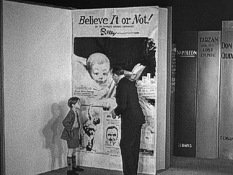 Where Ripley’s Believe It Or Not! really scores in this disc package is with its cover artwork, sporting the new-look Warner Archive Collection style with a snazzy new cover design for the line, which breaks away from the uniformed approach so far of just the title treatment and a poster image for something that looks much more like a mainstream release. Still saving design costs, original theatrical poster art is employed to good effect, while the back of the sleeve and disc artwork feature updated versions of the WB Archive designs.
Where Ripley’s Believe It Or Not! really scores in this disc package is with its cover artwork, sporting the new-look Warner Archive Collection style with a snazzy new cover design for the line, which breaks away from the uniformed approach so far of just the title treatment and a poster image for something that looks much more like a mainstream release. Still saving design costs, original theatrical poster art is employed to good effect, while the back of the sleeve and disc artwork feature updated versions of the WB Archive designs.
Other series collections have been helpful in providing episode title listings on the back, but since Ripley’s has more of a documentary magazine style, there’s less call for that here. The standard keepcase holds the two discs, one in a flap tray and, as always with the Archive Collection, although the discs look like DVD-Rs, Warners insist they use specific discs and propriety production software that make them more robust than home-made creations, which does seem to be the case.
Cinematic Classic or Faded Print?
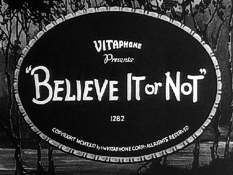 I remain a big fan of the Warner Archives and the many titles, especially like these collections, that have been brought to DVD and might otherwise be languishing in the back of a vault somewhere. Not only do such sets actually provide good value in terms of what one is paying for in the running time, but they serve up previously hard to see material, and I look forward to sampling more from Warner Brothers’ early Vitaphone days via such collections as the Warner Bros. Big Band, Jazz And Swing Short Subject Collection already available, as well as again putting out my own aforementioned hopes for the very funny RKO comedy shorts of such robust performers as Edgar Kennedy and Leon Errol.
I remain a big fan of the Warner Archives and the many titles, especially like these collections, that have been brought to DVD and might otherwise be languishing in the back of a vault somewhere. Not only do such sets actually provide good value in terms of what one is paying for in the running time, but they serve up previously hard to see material, and I look forward to sampling more from Warner Brothers’ early Vitaphone days via such collections as the Warner Bros. Big Band, Jazz And Swing Short Subject Collection already available, as well as again putting out my own aforementioned hopes for the very funny RKO comedy shorts of such robust performers as Edgar Kennedy and Leon Errol.
Director Tim Burton was rumored to be devising a fictional account of Ripley’s explorations some years ago, but even though that project didn’t come to fruition, this is a rare chance to see the original in his prime, and of a vintage that only brings a further feeling of newsreel authenticity to each claim. Ripley brought many of these international locales and discoveries from around the world to the screen for the first time, and was always adamant that his stories could be backed up, often providing proof. As such, believe it or not, but these short slices of cinema – groundbreaking in their own way – are odd little gems in their own right.
and many others directly from the online store at WB ARCHIVE COLLECTION





